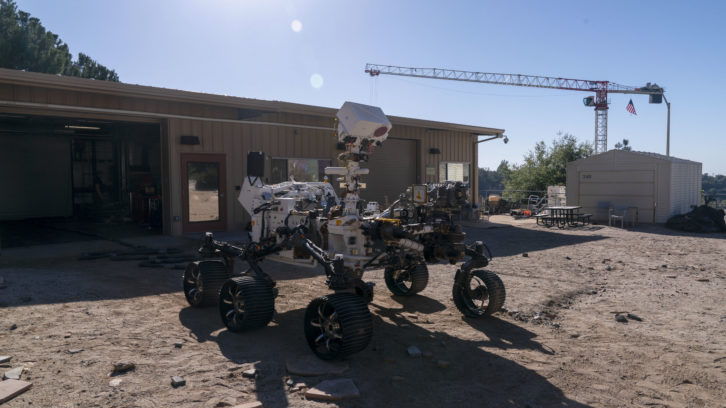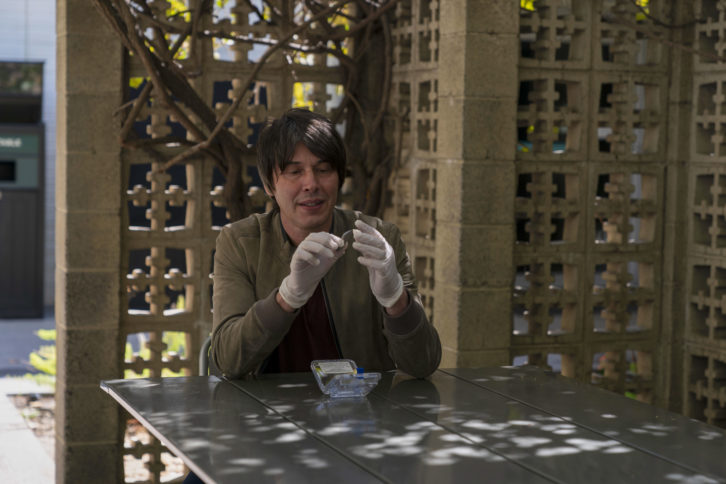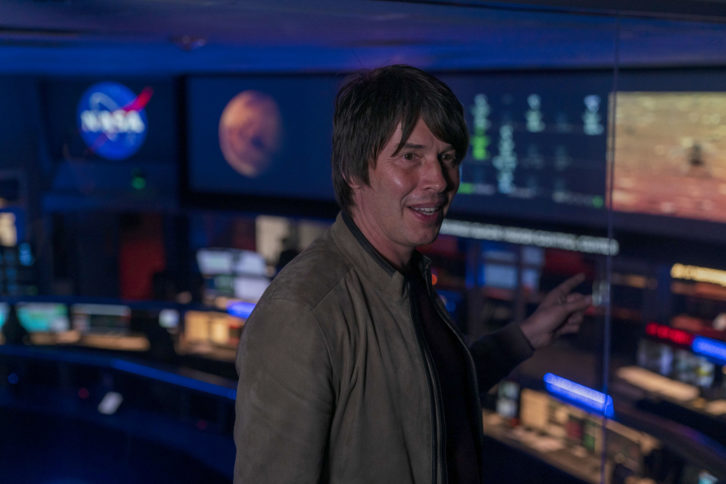In a new documentary for BBC Two, Professor Brian Cox spends a week going behind the scenes at NASA’s Jet Propulsion Laboratory (JPL), getting an exclusive look at mission control for the agency’s Mars mission.
Brian Cox: Seven Days on Mars, which broadcasts this Friday, has been produced by Arrow Media. The production company already has a strong relationship with NASA having partnered with the space agency on BAFTA and RTS Award-winning Live From Space eight years ago. They have since worked with NASA on America’s Secret Space Heroes for the Smithsonian Channel, and Apollo: The Forgotten Films for Discovery Channel.
“In the lead up to the Perseverance mission, we knew there was an opportunity to capitalise on our relationship with them,” executive producer Ash Potterton tells TVBEurope. “Live From Space was a live broadcast from the International Space Station, and having done that we have that bond of trust with NASA. Obviously these things sort of don’t happen overnight, but I think having that track record counted for a lot.
“We knew that there was an extraordinary story around the Perseverance mission. It was clearly a story that was going to capture the world’s attention, it’s pretty much the most ambitious mission that NASA has sent in modern times. And so that for us was definitely something that we wanted to try and get involved with and leverage the access that we have with NASA.”

Having been given the green light, the team at Arrow approached the BBC and Cox about their interest. “When Brian was was a child, he wrote a letter to JPL because he was just fascinated with all things space at that point,” explains Potterton. “He asked for information about some of their missions at the time, and they sent him some photographs and he still has them.”
“Brian says it was that which set him on the path to becoming a physicist and and so now he gets to go to JPL decades later, with a huge amount of excitement of being able to follow this mission for seven days. It is a personal journey for him.”
Viewers will see Cox follow the mission during the seven days he’s at JPL. “We wanted it to feel like an event film, which hopefully you’ll feel when you see it,” adds Potterton. “We wanted Brian to be in there, in the moment, following the twists and turns of the mission as it unfolded. It’s filmed on the hoof, it’s quite an observational documentary. That was a bit scary because we were going in there for seven days and we genuinely had no idea what was going to happen. In fact, even worse, we had no idea if anything would happen!”
As well as following the mission, the team were also granted access to areas that are typically off limits to non-NASA personnel. “We managed to get Brian into what’s called the Second Floor in one of the main buildings there, and that’s usually off limits. That was really special access,” states Potterton.

Filming took place in March after a postponement brought about by the pandemic. The team were originally due to fly to California in January, but that was changed as the Omicron wave moved around the world. “Despite the fact that our crew was going to bubble and we had extremely stringent Covid protocols, it was a significant concern because if Brian caught it and had to self isolate, that would be a big problem. There wasn’t any possibility of extending the shoot if he had to self isolate,” explains Potterton.
“And actually, we were incredibly fortunate even if it didn’t feel like it at the time. If we had filmed in that week in January, the Perseverance Rover in that week had some pebbles stuck inside it and it didn’t move an inch. So we began to realise actually we might have dodged a bullet.”
Instead, while Cox and the production team were on site in March, NASA had an ambition for the rover to set out on an epic road trip to reach the Jezero Delta, which is where it will take most of its samples and search for life. “It had an objective on that seven day period to reach a particular point en route to the Delta. It actually turned out in that week that the rover performed extraordinarily well and it actually broke the world record, or should I say a solar system record, for travelling further in any seven day period in that week than any rover’s ever done before,” laughs Potterton.
The film follows Cox and the Perseverance team as they receive data back from Mars that no human eyes have ever seen before. “I think it takes around 16 minutes for the images to be sent back to Earth, and Brian was there as the data came back and that was really exciting,” adds Potterton. “When he gets to JPL and finds out what the team at NASA are trying to do over that seven day period, the goal is established for Perseverance to reach this intermediate objective, which is this crater that is en route to the Delta. We follow that day by day as the data comes back the next day, showing how far Perseverance is gone each day. So there’s this unfolding narrative of whether it will or won’t reach its objectives within that seven days.
“Alongside that we tell the macro picture story of the search for life on Mars, and what why that matters, why we should care about that. We meet some of the key people at JPL who aren’t directly driving the rover but have got other really important roles on that mission. Through that we tell the story about the search for life on Mars, how we’ve got to where we are now, and what the significance of it is, what what kind of life might we expect to find? And ultimately, what the potential scenarios are about what it might discover and what that would mean for us and our understanding of ourselves in the context of life in the universe.”
All of this is told with the help of graphics that chart the progress of Perseverance over that seven day period. Viewers will also images from the rover itself to help tell its story. “Alongside that, we also worked with Sean Doran, who uses data and imagery from NASA to create incredibly powerful visuals of what it’s like on Mars,” explains Potterton. “He gives you that sense of almost being there. They’re really, really extraordinary visuals and they’re quite a prominent feature of the film because one of our ambitions was from the outset was to give you that feeling as much as possible that you’re there. We do say at the top of the film, apart from the occasional graphic, all the imagery that you’re seeing in the film is either taken from Perseverance or one of the other orbiters around Mars.”

But it wasn’t all plain sailing (or roving). There were challenges that the Perseverance team had to overcome during the seven days that Cox et al were on site. On their first day of shooting, Perseverance’s drill was stuck on a rock meaning it couldn’t move anywhere. The team at JPL had to send it a command to snap off the sample that was stuck on the drill so that it could start its journey to the Delta.
“Then, during the course of the week, the mission team lost access to something called the Deep Space Network, which essentially is the core communication device that allows them to communicate not just with Perseverance, but with all spacecraft out in the universe,” adds Potterton. “That means they had to do something that was quite risky and effectively try and send Perseverance information for two days.

“What they discovered was that during the second of those two days, the first drive went to plan. But on the second of the two days there was a fault with the upload that meant the rover didn’t move an inch on that second day. As they say in the film, these commands and instructions are interrogated and checked and rechecked multiple times, but there’s just always the possibility of human error and just one tiny slip in that code would mean that it would not process any commands for that 24 hour period. So there are challenges that happened during the course of filming that give a really compelling insight into the reality of space exploration. They’re not immune to just the reality of things that it’s really difficult and there’s constantly surprises waiting around every corner.”
Brian Cox: Seven Days on Mars is on BBC Two and iPlayer on Friday, 17th June at 9pm.







